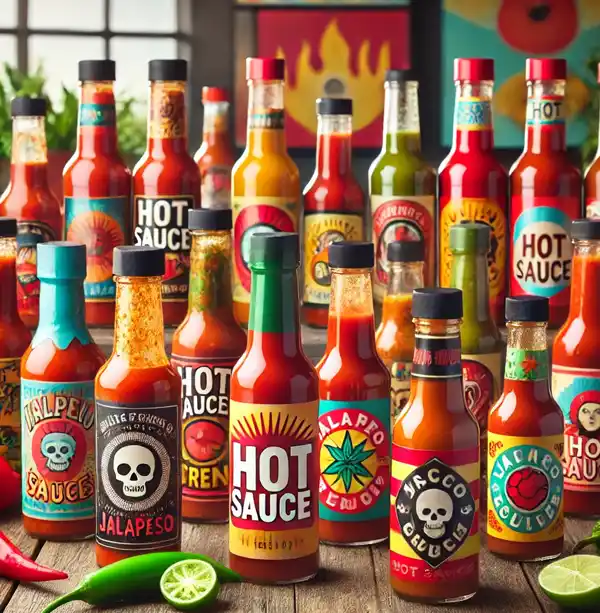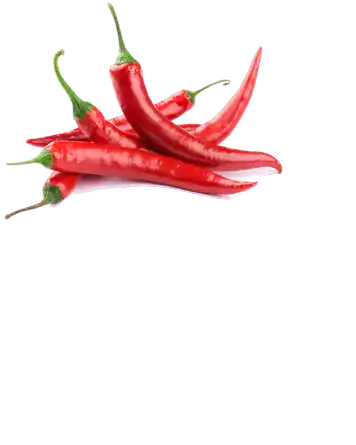Spice Up Your Life
Happy National Hot Sauce Day! Whether you like a gentle tangy kick or a fiery explosion that makes your eyes water, today is all about celebrating the liquid heat that spices up our lives: hot sauce.
The Fiery History of Hot Sauce
Hot sauce has been spicing up meals for thousands of years. The earliest known use of chili peppers in cuisine dates back to 7,000 BCE in Central and South America. Indigenous peoples used chili peppers not just for flavor but also for their medicinal properties. Chili peppers were considered sacred by some cultures and were used in rituals and as offerings to the gods. They weren’t just food; they were a symbol of vitality and power.
 When Christopher Columbus encountered chili peppers in the Americas, he mistakenly called them "peppers" because their heat reminded him of black pepper—and the name stuck. Spanish and Portuguese explorers quickly recognized the potential of this fiery fruit and spread it across Europe, Asia, and Africa. Chili peppers thrived in these new environments, and each culture began developing its own unique hot sauces. The tangy Tabasco sauce of Louisiana, the smoky and rich chipotle sauces of Mexico, and the tangy, spicy sambals of Southeast Asia are just a few examples of how chili peppers have been embraced and celebrated worldwide.
When Christopher Columbus encountered chili peppers in the Americas, he mistakenly called them "peppers" because their heat reminded him of black pepper—and the name stuck. Spanish and Portuguese explorers quickly recognized the potential of this fiery fruit and spread it across Europe, Asia, and Africa. Chili peppers thrived in these new environments, and each culture began developing its own unique hot sauces. The tangy Tabasco sauce of Louisiana, the smoky and rich chipotle sauces of Mexico, and the tangy, spicy sambals of Southeast Asia are just a few examples of how chili peppers have been embraced and celebrated worldwide.
By the 19th century, commercially bottled hot sauces began to appear, making it easier than ever for people to add a spicy kick to their meals. Today, hot sauce is a billion-dollar industry with a cult-like following, proving that humanity’s love affair with spice is as hot as ever.
What Makes Hot Sauce Hot?
The heat in hot sauce comes from capsaicin, a compound found in chili peppers. Capsaicin binds to receptors in your mouth and skin, tricking your brain into thinking it’s experiencing heat. The result? That satisfying burn that hot sauce lovers crave.
Capsaicin works by stimulating the TRPV1 receptor, which is responsible for detecting heat and pain. This receptor sends signals to your brain, making you feel like your mouth is on fire—even though there’s no actual temperature change. This unique reaction is why hot sauce provides such an intense sensory experience.
Interestingly, not all chili peppers are created equal when it comes to heat. The level of capsaicin varies by species, with some varieties like bell peppers containing none at all, while others, like habaneros and Carolina Reapers, pack a powerful punch. The chemical structure of capsaicin also makes it lipophilic, meaning it dissolves in fats but not water. That’s why drinking milk or eating something fatty, like cheese or yogurt, is more effective at quelling the burn than gulping down a glass of water.
The intensity of a chili pepper’s heat is measured on the Scoville scale, named after pharmacist Wilbur Scoville. A bell pepper rates a mild 0, while the Carolina Reaper, one of the hottest peppers in the world, clocks in at over 2 million Scoville Heat Units (SHUs). Some hot sauce brands use this scale to flaunt their fiery credentials, but beware: not all sauces are for the faint of heart. Some hot sauces even include extracts to amplify the heat, creating products so intense they’re best handled with gloves.
Beyond the physical sensation, capsaicin has fascinating chemical properties. It acts as a natural deterrent for mammals but is harmless to birds, which helps in the natural dispersal of chili seeds. This evolutionary advantage has ensured the widespread propagation of chili peppers, making them a staple ingredient in cuisines worldwide.
The Science of Spice
Did you know that eating spicy foods can make you happier? Capsaicin triggers the release of endorphins, your body’s natural painkillers, which create a sense of euphoria. This "spice high" is part of why some people find themselves addicted to the burn. It’s a thrill, a challenge, and a sensory experience all rolled into one.
Hot sauce may also have health benefits. Capsaicin has been studied for its ability to boost metabolism by raising your body’s temperature, helping you burn more calories. It’s also known for its anti-inflammatory properties, which can aid in reducing pain and swelling. Furthermore, some studies suggest that capsaicin might improve heart health by lowering blood pressure and cholesterol levels.
 Interestingly, the heat from capsaicin can also trick your body into releasing mucus and clearing out sinuses, making hot sauce a natural remedy for colds and allergies. So next time you reach for that bottle of hot sauce, know that you’re not just spicing up your meal—you’re doing your body a favor, too.
Interestingly, the heat from capsaicin can also trick your body into releasing mucus and clearing out sinuses, making hot sauce a natural remedy for colds and allergies. So next time you reach for that bottle of hot sauce, know that you’re not just spicing up your meal—you’re doing your body a favor, too.
How to Celebrate National Hot Sauce Day
National Hot Sauce Day is the perfect excuse to turn up the heat in your life. Whether you're a longtime lover of spicy flavors or just starting to explore the world of hot sauces, there are countless ways to make the day memorable. Celebrate solo, with friends, or even virtually with fellow spice enthusiasts around the globe. The key is to embrace the bold and fiery spirit of hot sauce while having a little fun along the way.
Here are some fun ways to celebrate National Hot Sauce Day:
- Host a Hot Sauce Tasting Party: Invite friends over to sample a variety of hot sauces, ranging from mild to wild. Don’t forget to have plenty of milk on hand for those who overestimate their spice tolerance.
- Try a New Recipe: Experiment with adding hot sauce to your favorite dishes. Drizzle it on eggs, mix it into mac and cheese, or even add a few drops to a cocktail for a spicy twist.
- DIY Hot Sauce: Feeling adventurous? Make your own hot sauce! All you need are chili peppers, vinegar, and some creativity. Add garlic, lime, or even fruit for a unique flavor.
- Spicy Challenges: Test your spice tolerance with friends by trying the hottest sauces you can find. Bonus points if you film your reactions—nothing brings people together like mutual suffering.
Fun Facts About Hot Sauce
Hot sauce is more than just a condiment—it’s a cultural phenomenon with a rich history and some truly fascinating quirks. From its ancient origins to its role in modern-day cuisine, hot sauce has left its mark on taste buds and traditions around the world. Here’s a look at some intriguing and fun tidbits that make hot sauce so special:
- The world’s most popular hot sauce brand, Tabasco, has been around since 1868.
- The largest bottle of hot sauce ever made weighed 1,000 pounds and contained over 2,000 pounds of chili peppers.
- Some hot sauces are so hot they come with warning labels, waiver forms, or even a trip to the hospital (looking at you, ghost pepper sauce).
- Hot sauce was included in U.S. military rations starting in the 1980s to make meals more palatable.
Hot sauce isn’t just a condiment; it’s a way of life. It’s a symbol of adventure, courage, and the willingness to push boundaries (and your taste buds) to their limits. So whether you’re a heat-seeker or a mild sauce enthusiast, grab a bottle of your favorite fiery condiment and celebrate National Hot Sauce Day with gusto. Just don’t forget the tissues—your nose might need them!
Please Share our Content






 When Christopher Columbus encountered chili peppers in the Americas, he mistakenly called them "peppers" because their heat reminded him of black pepper—and the name stuck. Spanish and Portuguese explorers quickly recognized the potential of this fiery fruit and spread it across Europe, Asia, and Africa. Chili peppers thrived in these new environments, and each culture began developing its own unique hot sauces. The tangy Tabasco sauce of Louisiana, the smoky and rich chipotle sauces of Mexico, and the tangy, spicy sambals of Southeast Asia are just a few examples of how chili peppers have been embraced and celebrated worldwide.
When Christopher Columbus encountered chili peppers in the Americas, he mistakenly called them "peppers" because their heat reminded him of black pepper—and the name stuck. Spanish and Portuguese explorers quickly recognized the potential of this fiery fruit and spread it across Europe, Asia, and Africa. Chili peppers thrived in these new environments, and each culture began developing its own unique hot sauces. The tangy Tabasco sauce of Louisiana, the smoky and rich chipotle sauces of Mexico, and the tangy, spicy sambals of Southeast Asia are just a few examples of how chili peppers have been embraced and celebrated worldwide. Interestingly, the heat from capsaicin can also trick your body into releasing mucus and clearing out sinuses, making hot sauce a natural remedy for colds and allergies. So next time you reach for that bottle of hot sauce, know that you’re not just spicing up your meal—you’re doing your body a favor, too.
Interestingly, the heat from capsaicin can also trick your body into releasing mucus and clearing out sinuses, making hot sauce a natural remedy for colds and allergies. So next time you reach for that bottle of hot sauce, know that you’re not just spicing up your meal—you’re doing your body a favor, too.








 "Sláinte!" is a traditional Irish expression used as a toast, equivalent to "Cheers!" in English.
"Sláinte!" is a traditional Irish expression used as a toast, equivalent to "Cheers!" in English.